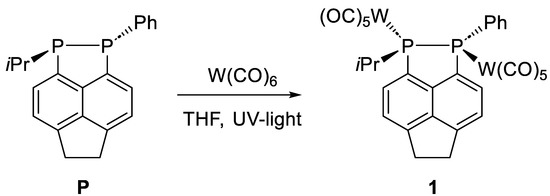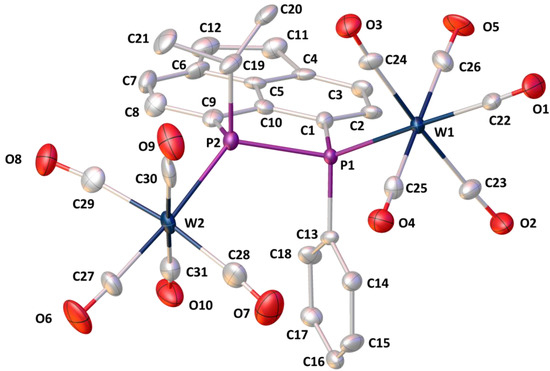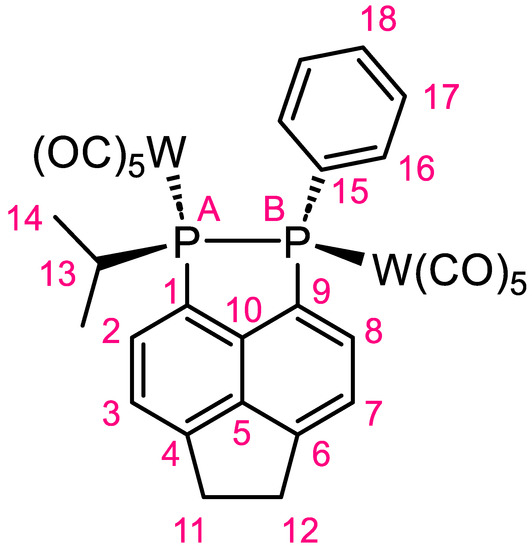Abstract
A binuclear tungsten(0) complex with an asymmetric bridging 1,2-diphosphole ligand was prepared by the photolysis of tungsten hexacarbonyl in the presence of 1-isopropyl-2-phenyl-1,2,5,6-tetrahydroacenaphtho [5,6-cd][1,2]diphosphole. The tungsten complex 1 was characterized by high resolution mass spectrometry, multinuclear NMR spectroscopy (1H, 13C, 31P), and elemental microanalysis. The structure of the trans isomer was resolved by single crystal X-ray diffraction, showing a slight elongation of the P−P bond upon coordination to the W(CO)5 groups.
1. Introduction
The symmetrically functionalised, 1,2-diphenyl-1,2-dihydronaphtho[1,8-cd][1,2]diphosphole (A) (Figure 1) has been shown to react with metals forming binuclear species, where the metal groups can be cis and trans to one another, with the P−P bond remaining intact [1,2]. Although the heating of A with W(CO)6 under UV irradiation results in a mixture of the cis and trans isomers (B), the cis-B isomer was prepared exclusively by separate stepwise reactions [3]. The cis isomers are reported to be much less thermodynamically stable than the trans isomers due to an increased steric repulsion between the two metal centres [3]. This is seen in cis-B and trans-B, where the P−P bond length is marginally longer in the cis isomer (2.280(2) vs. 2.270(1) Å, respectively).

Figure 1.
Structures of rigid naphthalene-based 1,2-diphospholes.
Using the symmetrically rigid 1,2-diphosphole A, Mizuta et al. produced a series of complexes bearing various transition metals such as Fe, Au, and W [1,2,3]. With the metal carbonyl complexes B and C, the trans isomer was the most stable. Upon stirring at ambient conditions for several days, cis-C converted to E with the loss of CO, the formation of an Fe−Fe bond, and the breaking of the P−P bond (P∙∙∙P separation in E is 2.7377(6) Å). No such reactions were observed for the trans isomers.
2. Results
An “unsymmetrical” derivative of A, bearing a rigid acenaphthene skeleton and two different substituents at phosphorus atoms, P, was synthesized by Kilian et al. via the dealkanative P−P coupling of bis(phosphines) [4]. The 1,2-diphosphole P is exclusively formed as the trans isomer from the dealkanative coupling. The synthesis of 1 involves a one-pot reaction where P and W(CO)6 are dissolved in THF and stirred under UV irradiation (365 nm) for 24 h (Scheme 1). After work-up, 1 was isolated and characterized, including the structure of trans-1, which was solved by X-ray crystallography.

Scheme 1.
Synthesis of compound (trans-1) by coordination of the asymmetric 1,2-diphosphole (P) to two W(CO)5 groups.
The 31P{1H} NMR spectrum of 1, shown in Figure 2a, indicates the formation of two products in an approximately 85:15 ratio. These products give rise to signals at δP 58.9 and 36.5 ppm (1JPP 182 Hz) and 46.2 and 19.2 ppm (1JPP 161 Hz). Further irradiation of the products with UV light results in no changes in the relative peak intensities. Tungsten has one NMR active isotope 183W (I = ½), which has a natural abundance of 14.31%. 183W satellite peaks can be observed for each of the four phosphorus resonances, with 1JPW varying from 232 Hz to 303 Hz, indicating that both products have both phosphorus atoms coordinated to tungsten. This suggests that a mixture of the trans and cis isomers of compound 1 have formed, with the most dominant product likely being that of trans-1. This is expected given the increased steric strain in the cis isomer and is supported by the findings of Muzuta et al. with their work on the naphthalene derivative. As the standard P−P bond is relatively weak (ca. 255 kJ/mol) [5], it is likely that the UV irradiation of the ligand during the reaction enables the cleavage of this bond, causing the observed isomerization.

Figure 2.
(a) The 31P{1H} NMR spectrum of compound 1, showing the presence of two products, the trans-1 (major) and cis-1 (minor). (b) Expansion of the phosphorus resonance (arising from trans-1) at δP 46.2 ppm, showing satellite peaks corresponding to the 1JPW coupling of 239 Hz. Full NMR spectra are available in the Supplementary Information, Figures S1–S4.
Crystals suitable for X-ray diffraction were grown from a solution in acetonitrile at 5 °C. The crystal structure revealed that of the two isomers present in the bulk, trans-1 crystallised. The structure of the (R,R) enantiomer of 1 is shown in Figure 3. There are a pair of crystallographically identical enantiomers, (R,R)-1 and (S,S)-1, in the solid-state structure. Selected bond lengths and angles are provided in Table 1 and selected crystallographic data are presented in Table S1 (Supplementary Information). There is no significant change in the splay angle of trans-1 compared with the free ligand (P). There is, however, a slight Increase in the P−P bond length to 2.261(6) Å (from 2.232(2) Å), suggesting that some electron density is removed from the phosphorus atoms on coordination [4].

Figure 3.
Molecular structure of (R,R)-1. Hydrogen atoms are omitted for clarity. Anisotropic displacement ellipsoids are set at the 50% probability level.

Table 1.
Selected lengths (Å) and angles (°) for trans-1.
Both the P−C bond lengths and the P−P−C bond angles remain unchanged compared to free ligand (P). There is a slight increase in the out-of-plane displacement of both peri-substituted groups, with one atom displaced by 0.098 Å and the other by 0.197 Å. This is a result of the steric repulsion between the two W(CO)5 groups and the acenaphthene backbone, which retains its rigidity with minimal twisting (C1−C10−C5−C6 of 177(1)°). The two P−W bond distances of 2.501(4) and 2.532(3) Å are as expected, and are very similar to those of trans-B [6]. Both tungsten atoms sit in an octahedral environment with minimal distortions, although some of the C≡O bonds in the carbonyl ligands that are cis to the 1,2-diphosphole are bent away from the ligand to reduce steric strain (e.g., W2−C28−O7 = 174.2(18)°). Both phosphorus atoms sit in distorted tetrahedral environments. Despite multiple attempts, we were unable to obtain a crystal structure of the second compound present in the bulk, which we propose is the cis isomer.
3. Materials and Methods
3.1. General Considerations
All synthetic manipulations were performed under an atmosphere of dry nitrogen using standard Schlenk techniques or under an argon atmosphere in a Saffron glove box. All glass apparatus were stored in a drying oven (ca. 120 °C) prior to use. Dry solvents were collected from an MBraun solvent purification system and stored over appropriate molecular sieves. Water used in experiments was subject to nitrogen sparging and stored under nitrogen prior to use. Chemicals were taken from the laboratory inventory and used without further purification. Compound P was prepared according to the published method [4].
All NMR spectra were recorded using a Bruker Avance III (500 MHz) spectrometer at 25 °C. Assignments of 1H and 13C spectra were made in conjunction with appropriate 2D spectra. For 1H and 13C NMR, tetramethylsilane was used as an external standard. For 31P NMR, 85% H3PO4 in D2O was used as the external standard. Residual solvent peaks were also used for calibration (CDCl3 δH 7.260 ppm; δC 77.160 ppm). Chemical shifts (δ) are given in parts per million (ppm). Coupling constants (J) are quoted in Hertz (Hz).
Melting and decomposition points were determined by heating solid samples in sealed glass capillaries using a Stuart SMP30 melting point apparatus. Mass spectrometry was performed at the EPSRC UK National Mass Spectrometry Facility in Swansea using a Finnigan MAT 95 XP (EI). Elemental analysis was performed by the EA Service at London Metropolitan University. Raman spectra were recorded on solid samples in glass capillaries using a Perkin-Elmer System 2000 NIR Fourier transform spectrometer with a dipole-pumped NdYAG laser, ranging between 30 and 150 mW power with a scanning range of 3500–100 cm−1.
3.2. Synthetic Procedure
Synthesis of (Decacarbonyl)(1-isopropyl-2-phenyl-1,2,5,6-tetrahydroacenaphtho [5,6-cd][1,2]diphosphole)ditungsten(0) (1)
1-isopropyl-2-phenyl-1,2,5,6-tetrahydroacenaphtho[5,6-cd][1,2]diphosphole, P, (300 mg, 0.89 mmol) and tungsten hexacarbonyl (663 mg, 1.88 mmol) were dissolved in tetrahydrofuran (100 mL) and irradiated with a 6 W Hg UV lamp for 24 h. Irradiation of W(CO)6 in THF produced W(CO)5(THF) in situ. Volatiles were removed in vacuo and excess W(CO)6 was removed by vacuum sublimation at 60 °C for 3 h, affording product 2, a mixture of cis- and trans isomers as a yellow powder (470 mg, 54%) (M.p. 163–166 °C). Anal calcd. for C31H20P2W2O10: C, 37.91; H, 2.05. Found: C, 38.04; H, 2.29. Raman: (glass capillary, cm−1) ν = 3069m (ν CH), 2936s (ν CH), 2078w, 1986vs (ν C=O), 1914m (ν C=O), 1609m (ν C-C), 1448m (ν C-C), 1419m (ν CH2), 1385m (ν CH3), 1030m, 1004m, 867m, 597m, 436s. HRMS (EI): C28H20P2W2O7+ (M−3CO)+ calculated 897.970, found 897.971; C25H20P2W2O4+ (M−6CO)+ calculated 813.9855, found 813.9862; C23H20P2WO2+ (M-W(CO)8)+ calculated 574.0448, found 574.0448; C21H20P2W+ (M-W(CO)10)+ calculated 518.0550, found 518.0546; C21H21P2 (M + H-W2(CO)10)+ calculated 335.1118, found 335.1122. The NMR numbering scheme is provided in Figure 4. Note, for 1H and 13C NMR spectra, resonances are assigned for the trans isomer. 1HMR: δH (500.1 MHz, CDCl3) 7.90 (1H, dd, 3JHH 7.6, 3JHP 7.6 Hz, H-8), 7.83 (1H, dd, 3JHP 9.3 3JHH 7.2 Hz, H-2), 7.63–7.60 (1H, m, H-7), 7.59 (1H, dd, 3JHH 7.2, 4JHP 2.3 Hz, H-3), 7.39–7.05 (5H, m, H-16–18) 3.63 (4H, s, H-11,12), 2.59 (1H, septd, 3JHH 6.7, 2JHP 6.7 Hz, H-13), 1.42 (3H, dd, 3JHP 20.0, 3JHH 6.9 Hz, H-14/14′), 0.71 (3H, dd, 3JHP 13.1, 3JHH 6.7 Hz, H-14/14′). 13C{1H} NMR: δC (126 MHz, CDCl3) 196.4 (d, 2JCP 6.6 Hz, CO), 196.0 (d, 2JCP 6.9 H, CO), 149.8 (s, qC-6), 149.7 (s, qC-4), 138.4 (dd, 1JCP 5.9, 2JCP 5.9 Hz, qC-1), 134.7 (dd, 2JCP 12.0, 3JCP 2.2 Hz, C-16), 134.0 (d, 2JCP 10.4 Hz, C-8), 133.3 (d, 2JCP 11.9 Hz, C-2), 131.4 (s, qC-15), 131.2 (s, C-18), 128.8 (d, 3JCP 9.9 Hz, C-17), 121.7 (d, 3JCP 10.3 Hz, C-7), 121.5 (d, 3JCP 9.5 Hz, C-3), 34.9 (dd, 1JCP 14.0, 2JCP 7.8 Hz, C-13), 31.1 (s, C-11,12), 20.7 (dd, 2JCP 4.6, 3JCP 4.6 Hz, C-14/14′), 20.3 (dd, 2JCP 5.0 Hz, 3JCP 5.0 Hz, C-14/14′).31P{1H} NMR: δP (202.5 Hz, CDCl3) 48.9 (d with 183W satellites, 1JPP 182 Hz, 1JWP 303 Hz, P-Acis), 46.2 (d with 183W satellites, 1JPP = 161 Hz, 1JWP = 293 Hz, P-Atrans), 36.5 (d with 183W satellites, 1JPP 182 Hz, 1JWP 232 Hz, P-Bcis), and 19.2 (d with 183W satellites, 1JPP 160 Hz, 1JWP 235 Hz, P-Btrans).

Figure 4.
NMR numbering scheme for 1.
Crystals of 1 suitable for single crystal X-ray diffraction were grown from acetonitrile at 5 °C. For X-ray crystallography, all data were collected at 125 K using the St Andrews Automated Robotic Diffractometer (STANDARD), consisting of a Rigaku sealed-tube generator, equipped with a SHINE monochromator (Mo Kα radiation (λ = 0.71075 Å)), and a Saturn 724 CCD area detector, coupled with a Microglide goniometer head and an ACTOR SM robotic sample changer [7]. Intensity data were collected using ω steps accumulating area detector images, spanning at least a hemisphere of reciprocal space. Data for all compounds analysed were collected and processed (including correction for Lorentz, polarization, and absorption) using CrystalClear [8]. Structures were solved by SHELXT and refined by full-matrix least-squares against F2 (SHELXL-2018/3) and expanded upon using Fourier techniques [9]. Non-hydrogen atoms were refined anisotropically, and hydrogen atoms were refined using a riding model. All calculations were performed using the CrystalStructure interface [10]. Images of structures were generated using OLEX-2 [11]. Selected crystallographic data are presented in Table S1.
4. Conclusions
A binuclear tungsten(0) complex with an unsymmetric, rigid, 1,2-diphosphole ligand was synthesised and the trans isomer characterised by NMR spectroscopy and single crystal X-ray diffraction as a pair of (R,R) and (S,S) enantiomers. The 31P{1H} NMR spectrum shows coupling between 31P and 183W confirming both phosphorus atoms in the ligand are coordinated by pentacarbonyltungsten(0) groups.
Supplementary Materials
The following supporting information can be downloaded online. Figures S1–S4: NMR spectra of 1; Table S1: Selected crystallographic data.
Author Contributions
Z.H.D. and L.J.T. carried out the required synthetic steps and preliminary analysis. C.L.C.-W. collected the X-ray data and solved the structures. B.A.C. and Z.H.D. collected and carried out the analysis of the other spectroscopic data. P.K. and B.A.C. designed the study, analysed the data, and wrote the manuscript. Z.H.D., B.A.C., P.K. and A.M.Z.S. provided supervision and laboratory equipment. All authors have read and agreed to the published version of the manuscript.
Funding
This research received no external funding.
Institutional Review Board Statement
Not applicable.
Informed Consent Statement
Not applicable.
Data Availability Statement
CCDC 2264466 contains the supplementary crystallographic data for this paper. These data can be obtained free of charge from The Cambridge Crystallographic Data Centre via www.ccdc.cam.ac.uk/structures.
Acknowledgments
The authors express their gratitude to the University of St Andrews School of Chemistry and P.K. for the use of their laboratory facilities and provision of materials.
Conflicts of Interest
The authors declare no conflict of interest.
References
- Mizuta, T.; Kunikata, S.; Miyoshi, K. Synthesis and molecular structures of dinuclear complexes with 1,2-dihydro-1,2-diphenyl-naphtho[1,8-c,d]1,2-diphosphole as a bridging ligand. J. Organomet. Chem. 2004, 689, 2624–2632. [Google Scholar] [CrossRef]
- Teramoto, Y.; Kubo, K.; Kume, S.; Mizuta, T. Formation of a Hexacarbonyl Diiron Complex Having a Naphthalene-1,8-bis(phenylphosphido) Bridge and the Electrochemical Behavior of Its Derivatives. Organometallics 2013, 32, 7014–7024. [Google Scholar] [CrossRef]
- Teramoto, Y.; Kubo, K.; Mizuta, T. PhP–PPh group bound to 1,8-positions of naphthalene: Preparation of cis isomer and synthesis of binuclear complex. J. Organomet. Chem. 2011, 696, 3402–3407. [Google Scholar] [CrossRef]
- Taylor, L.J.; Bühl, M.; Chalmers, B.A.; Ray, M.J.; Wawrzyniak, P.; Walton, J.C.; Cordes, D.B.; Slawin, A.M.Z.; Woollins, J.D.; Kilian, P. Dealkanative Main Group Couplings across the peri-Gap. J. Am. Chem. Soc. 2017, 139, 18545–18551. [Google Scholar] [CrossRef] [PubMed]
- Corbridge, Derek, E.C. Phosphorus World: Chemistry, Biochemistry and Technology; CD-ROM; Great Britain: Harrogate, UK, 2005; p. 76. [Google Scholar]
- Thomas, I.R.; Bruno, I.L.; Cole, J.C.; Macrae, C.F.; Pidcock, E.; Wood, P.A. WebCSD: The online portal to the Cambridge Structural Database. J. Appl. Cryst. 2010, 43, 362–366. [Google Scholar] [CrossRef] [PubMed]
- Fuller, A.L.; Scott-Hayward, L.A.S.; Li, Y.; Buhl, M.; Slawin, A.M.Z.; Woollins, J.D. Automated Chemical Crystallography. J. Am. Chem. Soc. 2010, 132, 5799–5802. [Google Scholar] [CrossRef] [PubMed]
- CrystalClear-SM Expert v2.1, Rigaku Americas: The Woodlands, TX, USA; Rigaku Corporation: Tokyo, Japan, 2015.
- Sheldrick, G.M. Crystal structure refinement with SHELXL. Acta Crystallogr. Sect. C Struct. Chem. 2015, 71, 3–8. [Google Scholar] [CrossRef] [PubMed]
- CrystalStructure v4.3.0, Rigaku Americas: The Woodlands, TX, USA; Rigaku Corporation: Tokyo, Japan, 2018.
- Dolomanov, O.V.; Bourhis, L.J.; Gildea, R.J.; Howard, J.A.K.; Puschmann, H. OLEX2: A complete structure solution, refinement and analysis program. J. Appl. Cryst. 2009, 42, 339–341. [Google Scholar] [CrossRef]
Disclaimer/Publisher’s Note: The statements, opinions and data contained in all publications are solely those of the individual author(s) and contributor(s) and not of MDPI and/or the editor(s). MDPI and/or the editor(s) disclaim responsibility for any injury to people or property resulting from any ideas, methods, instructions or products referred to in the content. |
© 2023 by the authors. Licensee MDPI, Basel, Switzerland. This article is an open access article distributed under the terms and conditions of the Creative Commons Attribution (CC BY) license (https://creativecommons.org/licenses/by/4.0/).